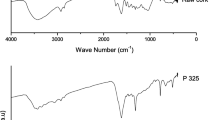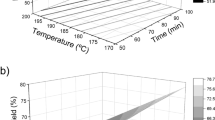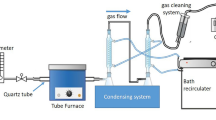Abstract
Liquids obtained by fractional condensation of pyrolysis vapors from two types of lignocellulosic biomass, namely Jerusalem artichoke stalk (high cellulose and ash contents) and white birch bark (high lignin and extractive contents), were compared. Using two condensers connected in series, a dark oily fraction rich in phenolic compounds and sugar derivatives was obtained at 90 °C (respectively, 14% of total polyphenols and 11% of total carbohydrates for the oily fraction from the agricultural stalk) followed by aqueous fraction at 0 °C. Stalk yielded a homogeneous oily fraction whereas the bark oily liquid was heterogeneous, due possibly to lignin pyrolysis products. Both yielded clear orange aqueous fractions having a chemical composition close to wood vinegar, > 60% water, and high concentrations of acetic acid, with also a significant content of polyphenols, around 5%. This study showed that fractional condensation could be a vital tool in pyrolysis-based biorefinery producing an oily (application as an energy source or as a chemical feedstock) and an aqueous fraction (applications as biocide or biostimulation in agriculture) by pyrolysis of vastly different lignocellulosic biomasses.



Similar content being viewed by others
Data availability
Not applicable
References
Mohan D, Pittman CU Jr, Steele PH (2006) Pyrolysis of wood/biomass for bio-oil: a critical review. Energy Fuel 20:848–889. https://doi.org/10.1021/ef0502397
Staš M, Kubička D, Chudoba J, Pospíšil M (2014) Overview of analytical methods used for chemical characterization of pyrolysis bio-oil. Energy Fuel 28:385–402. https://doi.org/10.1021/ef402047y
Pinheiro Pires AP, Arauzo J, Fonts I et al (2019) Challenges and opportunities for bio-oil refining: a review. Energy Fuels 0:null. https://doi.org/10.1021/acs.energyfuels.9b00039
Meier D (2019) Pyrolysis Oil Biorefinery. In: Wagemann K, Tippkötter N (eds) Biorefineries. Springer International Publishing, Cham, pp 301–337
Papari S, Hawboldt K (2018) A review on condensing system for biomass pyrolysis process. Fuel Process Technol 180:1–13. https://doi.org/10.1016/j.fuproc.2018.08.001
Oasmaa A, Fonts I, Pelaez-Samaniego MR et al (2016) Pyrolysis oil multiphase behavior and phase stability: a review. Energy Fuel 30:6179–6200. https://doi.org/10.1021/acs.energyfuels.6b01287
Lindfors C, Kuoppala E, Oasmaa A et al (2014) Fractionation of bio-oil. Energy Fuel 28:5785–5791. https://doi.org/10.1021/ef500754d
Chang C-C, Wu S-R, Lin C-C et al (2012) Fast pyrolysis of biomass in pyrolysis gas: fractionation of pyrolysis vapors using a spray of bio-oil. Energy Fuel 26:2962–2967. https://doi.org/10.1021/ef201858h
Sui H, Yang H, Shao J et al (2014) Fractional condensation of multicomponent vapors from pyrolysis of cotton stalk. Energy Fuel 28:5095–5102. https://doi.org/10.1021/ef5006012
Westerhof RJM, Brilman DWF, Garcia-Perez M et al (2011) Fractional condensation of biomass pyrolysis vapors. Energy Fuel 25:1817–1829. https://doi.org/10.1021/ef2000322
Pollard AS, Rover MR, Brown RC (2012) Characterization of bio-oil recovered as stage fractions with unique chemical and physical properties. J Anal Appl Pyrolysis 93:129–138. https://doi.org/10.1016/j.jaap.2011.10.007
Gooty AT, Li D, Berruti F, Briens C (2014) Kraft-lignin pyrolysis and fractional condensation of its bio-oil vapors. J Anal Appl Pyrolysis 106:33–40. https://doi.org/10.1016/j.jaap.2013.12.006
Gooty AT, Li D, Briens C, Berruti F (2014) Fractional condensation of bio-oil vapors produced from birch bark pyrolysis. Sep Purif Technol 124:81–88. https://doi.org/10.1016/j.seppur.2014.01.003
Scott DS, Piskorz J, Bergougnou MA et al (1988) The role of temperature in the fast pyrolysis of cellulose and wood. Ind Eng Chem Res 27:8–15. https://doi.org/10.1021/ie00073a003
Schulzke T, Conrad S, Westermeyer J (2016) Fractionation of flash pyrolysis condensates by staged condensation. Biomass Bioenergy 95:287–295. https://doi.org/10.1016/j.biombioe.2016.05.022
Adjalle K, Larose L-V, Bley J, Barnabé S (2017) The effect of organic nitrogenous compound content and different pretreatments on agricultural lignocellulosic biomass characterization methods. Cellulose 24:1395–1406. https://doi.org/10.1007/s10570-017-1199-8
Soest PJV, Robertson JB, Lewis BA (1991) Methods for dietary fiber, neutral detergent fiber, and nonstarch polysaccharides in relation to animal nutrition. J Dairy Sci 74:3583–3597. https://doi.org/10.3168/jds.S0022-0302(91)78551-2
Verma M, Godbout S, Solomatnikova O et al System and process for thermochemical treatment of matter containing organic compounds. 30 pages, WO 2012/126096 A1, published 27/09/2012
Brassard P, Godbout S, Raghavan V et al (2017) The production of engineered biochars in a vertical auger pyrolysis reactor for carbon sequestration. Energies:10. https://doi.org/10.3390/en10030288
Schulzke T, Conrad S, Shumeiko B, Auersvald M, Kubička D, Raymakers LFJM (2020) Fuels from Reliable Bio-based Refinery Intermediates: BioMates. Waste Biomass Valorization 11:579–598. https://doi.org/10.1007/s12649-019-00625-w
Kim P, Weaver S, Noh K, Labbé N (2014) Characteristics of bio-oils produced by an intermediate semipilot scale pyrolysis auger reactor equipped with multistage condensers. Energy Fuel 28:6966–6973. https://doi.org/10.1021/ef5016186
Faix O, Fortmann I, Bremer J, Meier D (1991) Thermal-degradation products of wood—gas-chromatographic separation and mass-spectrometric characterization of polysaccharide derived products. Holz Roh Werkst 49:213–219. https://doi.org/10.1007/BF02613278
Faix O, Meier D, Fortmann I (1990) Thermal-degradation products of wood—gas-chromatographic separation and mass-spectrometric characterization of monomeric lignin derived products. Holz Roh Werkst 48:281–285. https://doi.org/10.1007/BF02626519
Faix O, Fortmann I, Bremer J, Meier D (1991) Thermal degradation products of wood: a collection of electron-impact (EI) mass spectra of polysaccharide derived products. Holz Roh Werkst 49:299–304. https://doi.org/10.1007/BF02663795
Faix O, Meier D, Fortmann I (1990) Thermal degradation products of wood: a collection of electron-impact (EI) mass spectra of monomeric lignin derived products. Holz Roh Werkst 48:351–354. https://doi.org/10.1007/BF02639897
Ralph J, Hatfield RD (1991) Pyrolysis-GC-MS characterization of forage materials. J Agric Food Chem 39:1426–1437. https://doi.org/10.1021/jf00008a014
Singleton VL, Orthofer R, Lamuela-Raventós RM (1999) [14] Analysis of total phenols and other oxidation substrates and antioxidants by means of folin-ciocalteu reagent. In: Oxidants and Antioxidants Part A. Academic Press, pp 152–178
Rover MR, Brown RC (2013) Quantification of total phenols in bio-oil using the Folin–Ciocalteu method. J Anal Appl Pyrolysis 104:366–371. https://doi.org/10.1016/j.jaap.2013.06.011
Stankovikj F, McDonald AG, Helms GL et al (2017) Characterization of the water-soluble fraction of woody biomass pyrolysis oils. Energy Fuel 31:1650–1664. https://doi.org/10.1021/acs.energyfuels.6b02950
Albalasmeh AA, Berhe AA, Ghezzehei TA (2013) A new method for rapid determination of carbohydrate and total carbon concentrations using UV spectrophotometry. Carbohydr Polym 97:253–261. https://doi.org/10.1016/j.carbpol.2013.04.072
DuBois M, Gilles KA, Hamilton JK et al (1956) Colorimetric method for determination of sugars and related substances. Anal Chem 28:350–356. https://doi.org/10.1021/ac60111a017
Rover MR, Johnston PA, Lamsal BP, Brown RC (2013) Total water-soluble sugars quantification in bio-oil using the phenol–sulfuric acid assay. J Anal Appl Pyrolysis 104:194–201. https://doi.org/10.1016/j.jaap.2013.08.004
Godin B, Ghysel F, Agneessens R et al (2010) Détermination de la cellulose, des hémicelluloses, de la lignine et des cendres dans diverses cultures lignocellulosiques dédiées à la production de bioéthanol de deuxième génération. Biotechnol Agron Soc Environ 14:549–560
Gunnarsson IB, Svensson S-E, Johansson E et al (2014) Potential of Jerusalem artichoke (Helianthus tuberosus L.) as a biorefinery crop. Ind Crop Prod 56:231–240. https://doi.org/10.1016/j.indcrop.2014.03.010
Stefanidis SD, Kalogiannis KG, Iliopoulou EF et al (2014) A study of lignocellulosic biomass pyrolysis via the pyrolysis of cellulose, hemicellulose and lignin. J Anal Appl Pyrolysis 105:143–150. https://doi.org/10.1016/j.jaap.2013.10.013
Vassilev SV, Baxter D, Andersen LK et al (2012) An overview of the organic and inorganic phase composition of biomass. Fuel 94:1–33. https://doi.org/10.1016/j.fuel.2011.09.030
Sun W-G, Zhao H, Yan H-X et al (2012) The pyrolysis characteristics and kinetics of Jerusalem artichoke stalk using thermogravimetric analysis. Energy Sources A Recover Utilization Environ Effects 34:626–635. https://doi.org/10.1080/15567036.2011.615006
Mullen CA, Boateng AA, Goldberg NM (2013) Production of deoxygenated biomass fast pyrolysis oils via product gas recycling. Energy Fuel 27:3867–3874. https://doi.org/10.1021/ef400739u
Pittman CU Jr, Mohan D, Eseyin A et al (2012) Characterization of bio-oils produced from fast pyrolysis of corn stalks in an auger reactor. Energy Fuel 26:3816–3825. https://doi.org/10.1021/ef3003922
Azargohar R, Jacobson KL, Powell EE, Dalai AK (2013) Evaluation of properties of fast pyrolysis products obtained, from Canadian waste biomass. J Anal Appl Pyrolysis 104:330–340. https://doi.org/10.1016/j.jaap.2013.06.016
Ingram L, Mohan D, Bricka M et al (2008) Pyrolysis of wood and bark in an auger reactor: physical properties and chemical analysis of the produced bio-oils. Energy Fuel 22:614–625. https://doi.org/10.1021/ef700335k
Jendoubi N, Broust F, Commandre JM et al (2011) Inorganics distribution in bio oils and char produced by biomass fast pyrolysis: the key role of aerosols. J Anal Appl Pyrolysis 92:59–67. https://doi.org/10.1016/j.jaap.2011.04.007
Liaw S-S, Wang Z, Ndegwa P et al (2012) Effect of pyrolysis temperature on the yield and properties of bio-oils obtained from the auger pyrolysis of Douglas Fir wood. J Anal Appl Pyrolysis 93:52–62. https://doi.org/10.1016/j.jaap.2011.09.011
Kanaujia PK, Sharma YK, Garg MO et al (2014) Review of analytical strategies in the production and upgrading of bio-oils derived from lignocellulosic biomass. J Anal Appl Pyrolysis 105:55–74. https://doi.org/10.1016/j.jaap.2013.10.004
O'Connell MM, Bentley MD, Campbell CS, Cole BJW (1988) Betulin and lupeol in bark from four white-barked birches. Phytochemistry 27:2175–2176. https://doi.org/10.1016/0031-9422(88)80120-1
Fagernas L, Kuoppala E, Tiilikkala K, Oasmaa A (2012) Chemical composition of birch wood slow pyrolysis products. Energy Fuel 26:1275–1283. https://doi.org/10.1021/ef2018836
Ohira T (2012) Functional substances obtained through biomass pyrolysis—functions of acid liquid, bamboo vinegar, etc. - http://www.biocharinternational.org/sites/default/files/Bamboo_Vinegar_Japan_2012.pdf. Accessed 28 Sept. 2019
Kim P, Weaver S, Labbe N (2016) Effect of sweeping gas flow rates on temperature-controlled multistage condensation of pyrolysis vapors in an auger intermediate pyrolysis system. J Anal Appl Pyrolysis 118:325–334. https://doi.org/10.1016/j.jaap.2016.02.017
Grewal A, Abbey L, Gunupuru LR (2018) Production, prospects and potential application of pyroligneous acid in agriculture. J Anal Appl Pyrolysis 135:152–159. https://doi.org/10.1016/j.jaap.2018.09.008
Mattos C, Veloso MCC, Romeiro GA, Folly E (2019) Biocidal applications trends of bio-oils from pyrolysis: characterization of several conditions and biomass, a review. J Anal Appl Pyrolysis 139:1–12. https://doi.org/10.1016/j.jaap.2018.12.029
Acknowledgments
Special thanks go to Cédric Morin for his technical assistance and to Olga Solomatnikova for her pyrolysis expertise.
Funding
This work was supported by funding from MITACS (IT07388).
Author information
Authors and Affiliations
Corresponding author
Ethics declarations
Conflict of interest
The authors declare that they have no conflict of interest.
Code availability
Not applicable
Additional information
Publisher’s Note
Springer Nature remains neutral with regard to jurisdictional claims in published maps and institutional affiliations.
Rights and permissions
About this article
Cite this article
Le Roux, É., Barnabé, S., Godbout, S. et al. Production and characterization of two fractions of pyrolysis liquid from agricultural and wood residues. Biomass Conv. Bioref. 12, 3333–3343 (2022). https://doi.org/10.1007/s13399-020-01015-2
Received:
Revised:
Accepted:
Published:
Issue Date:
DOI: https://doi.org/10.1007/s13399-020-01015-2




